Analysis of the Possible Use of Straw from Agriculture as an Environmental Insulation Material in Buildings
Abstract
1. Introduction
2. Materials and Methods
2.1. Selection of Suitable Input Raw Materials
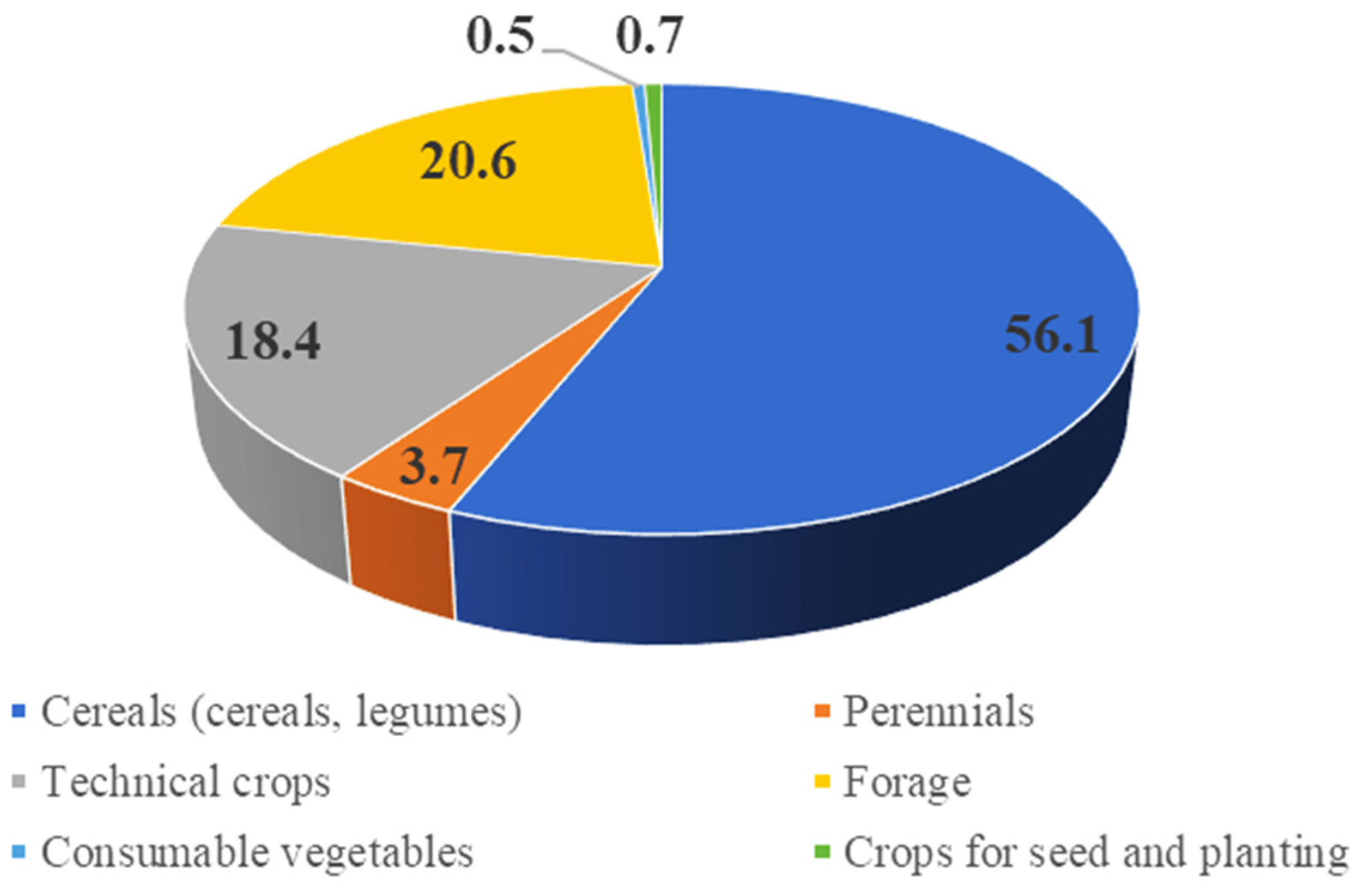
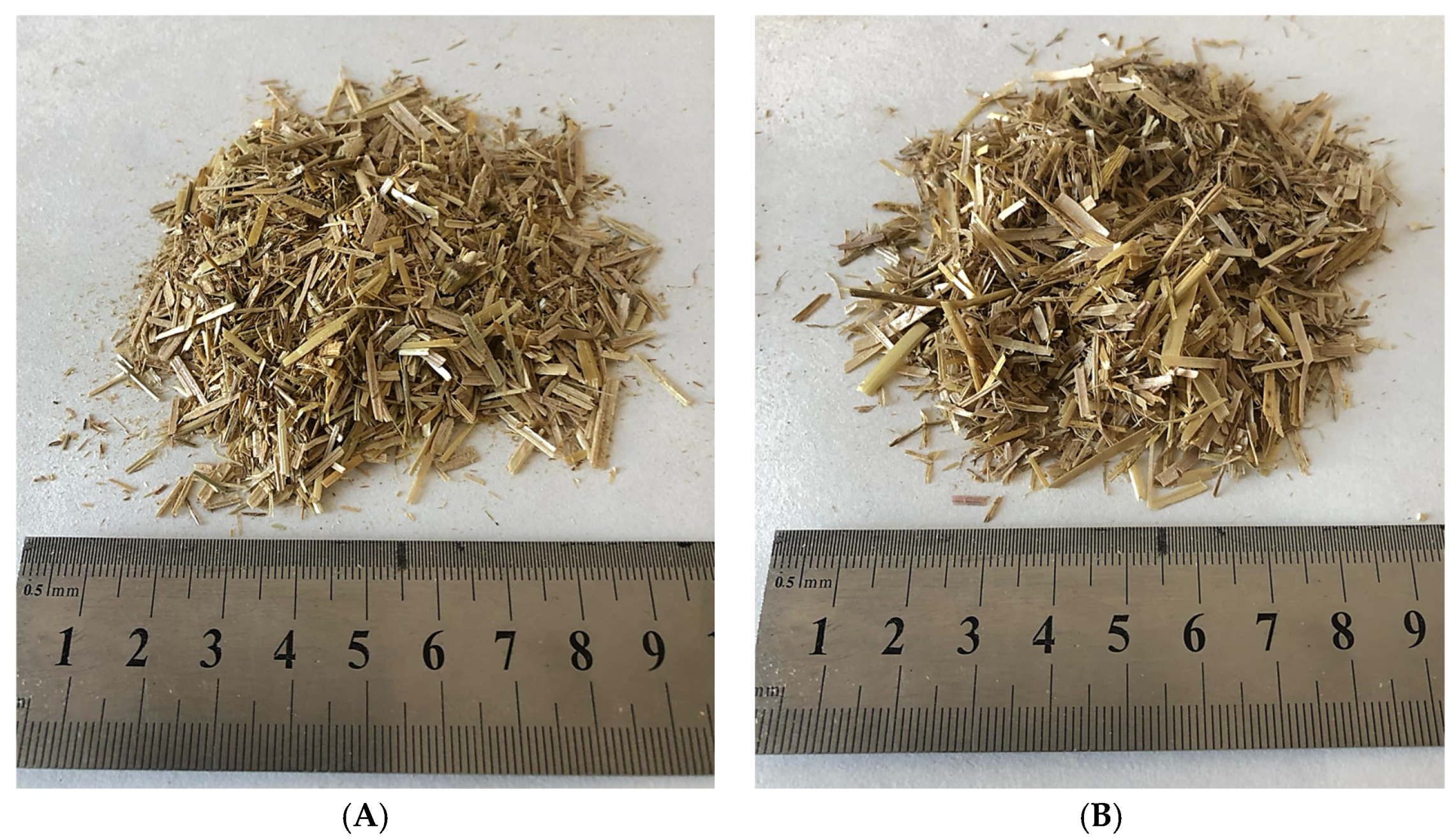
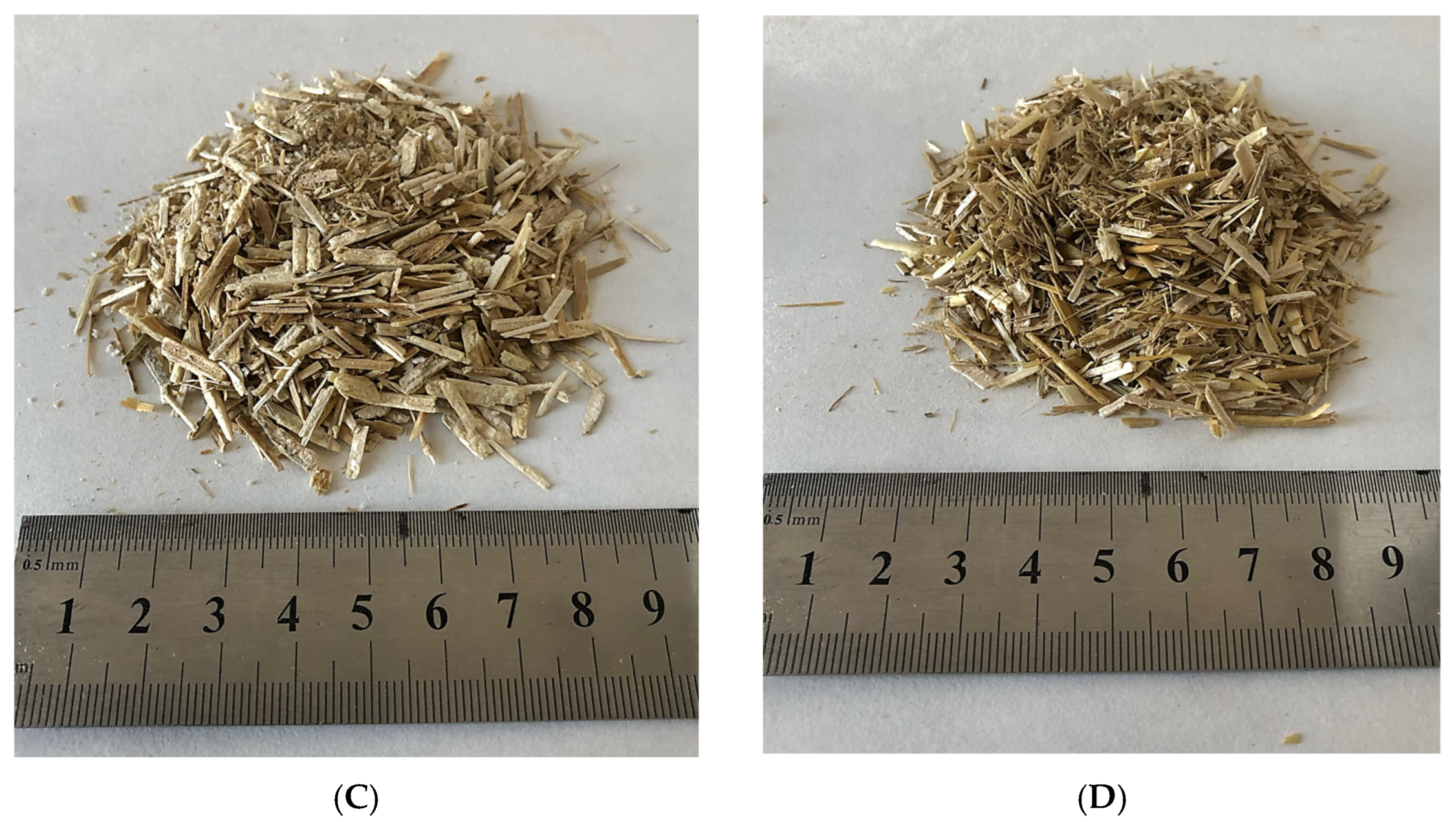
| Raw Materials | Percentage Content [wt.%] | ||
|---|---|---|---|
| Cellulose | Hemicellulose | Lignin | |
| Sorghum | 32–35 | 24–27 | 15–21 |
| Barley | 36–43 | 24–33 | 6–9 |
| Oats | 31–35 | 20–26 | 10–15 |
| Wheat | 35–39 | 23–30 | 12–16 |
| Triticale (hybrid cereal—wheat and rye) | 48–50 | 25–27 | 15–17 |
| Oilseed rape | 49–52 | 12–15 | 16–19 |
| Sunflower | 34–42 | 13–33 | 12–30 |
| Hemp | 64–71 | 17–24 | 6–8 |
| Flax | 65–75 | 13–26 | 5–7 |
| Coniferous wood | 33–42 | 22–40 | 27–32 |
| Deciduous wood | 38–51 | 17–18 | 21–31 |
2.2. Laboratory Testing Methodology
- Determination of loose density
- -
- —loose density of straw [kg/m3];
- -
- —weight of test samples [kg];
- -
- —volume of testing container [m3].
- Determination of grain size by sieve analysis
- Determination of thermal conductivity
3. Results
3.1. Evaluation of the Results of the Loose Density Determination
3.2. Evaluation of the Results of Sieve Analysis
3.3. Evaluation of Determination of Thermal Conductivity
4. Discussion
5. Conclusions
Author Contributions
Funding
Institutional Review Board Statement
Informed Consent Statement
Data Availability Statement
Conflicts of Interest
Abbreviations
| SEM | Scanning electron microscopy |
| EPS | Expanded polystyrene |
| XPS | Extruded polystyrene |
| EPBD | Energy Performance of Buildings Directive |
Appendix A
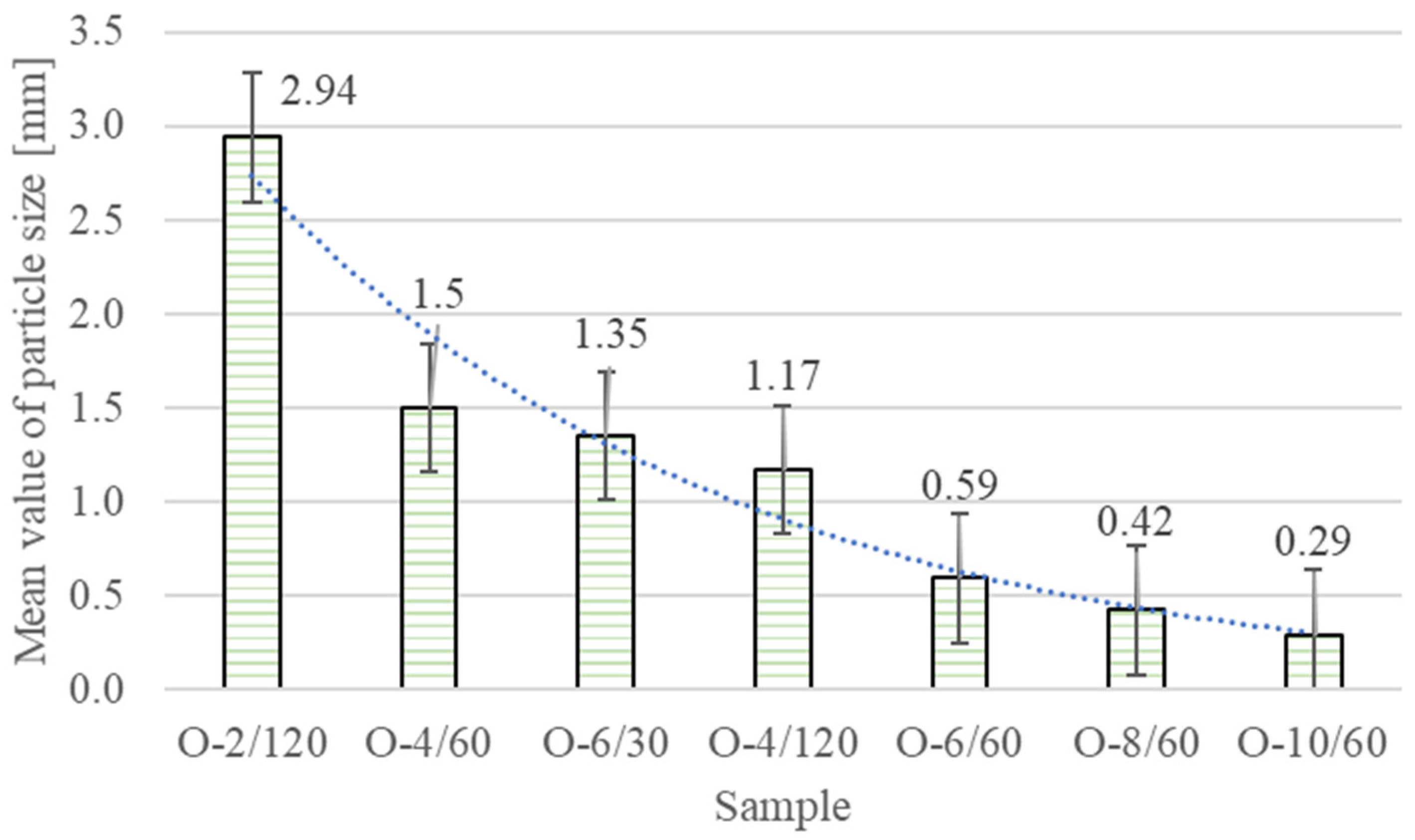
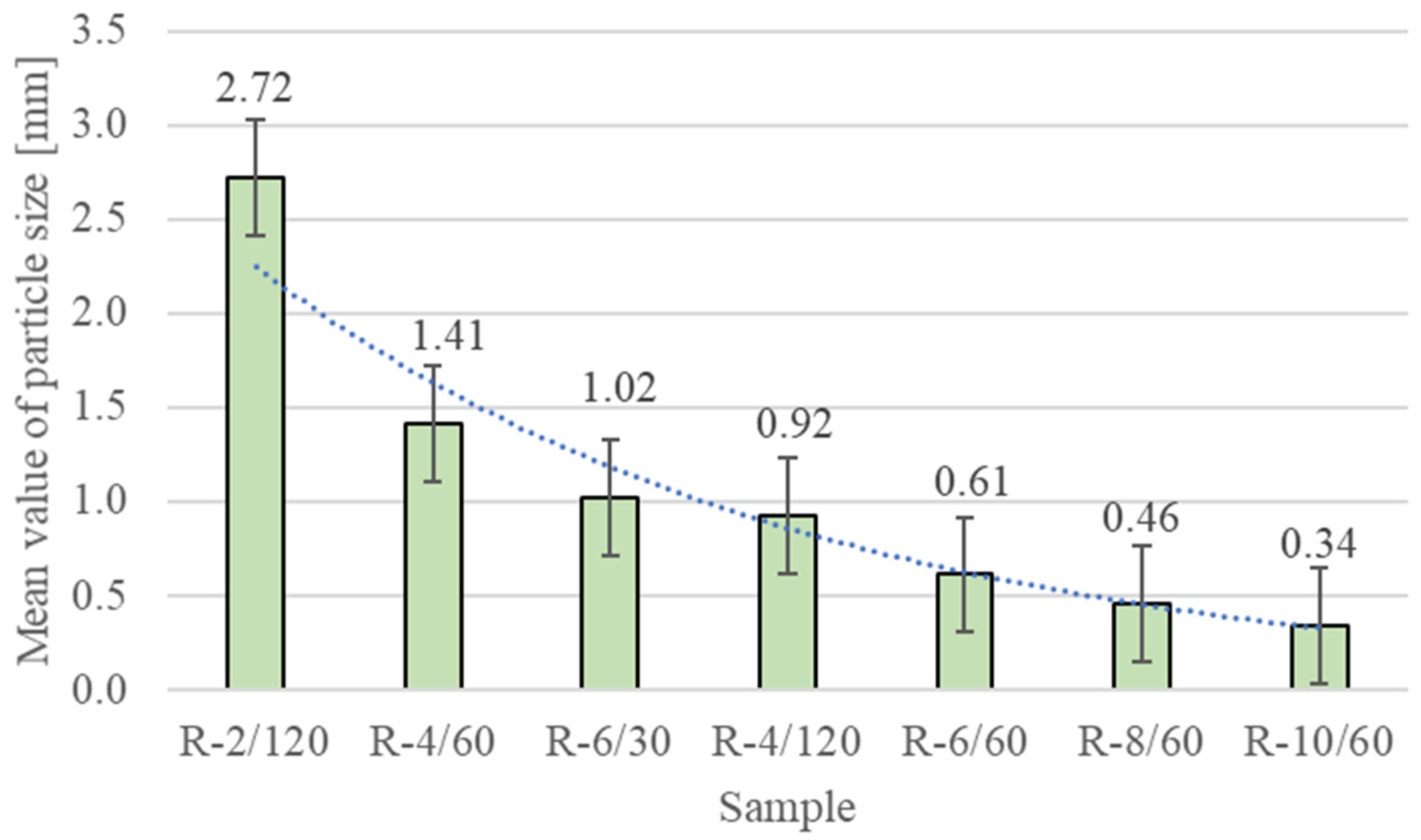

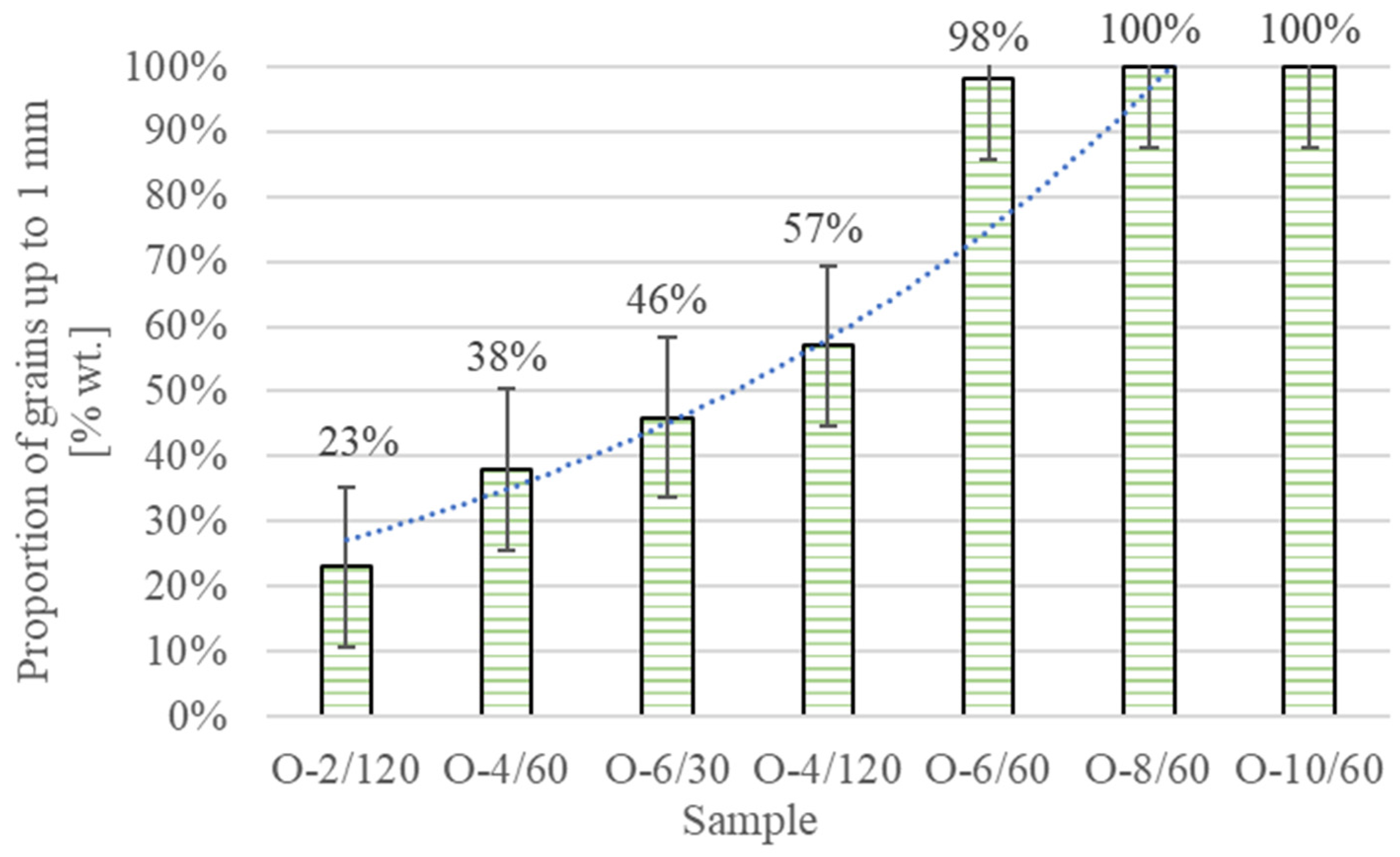
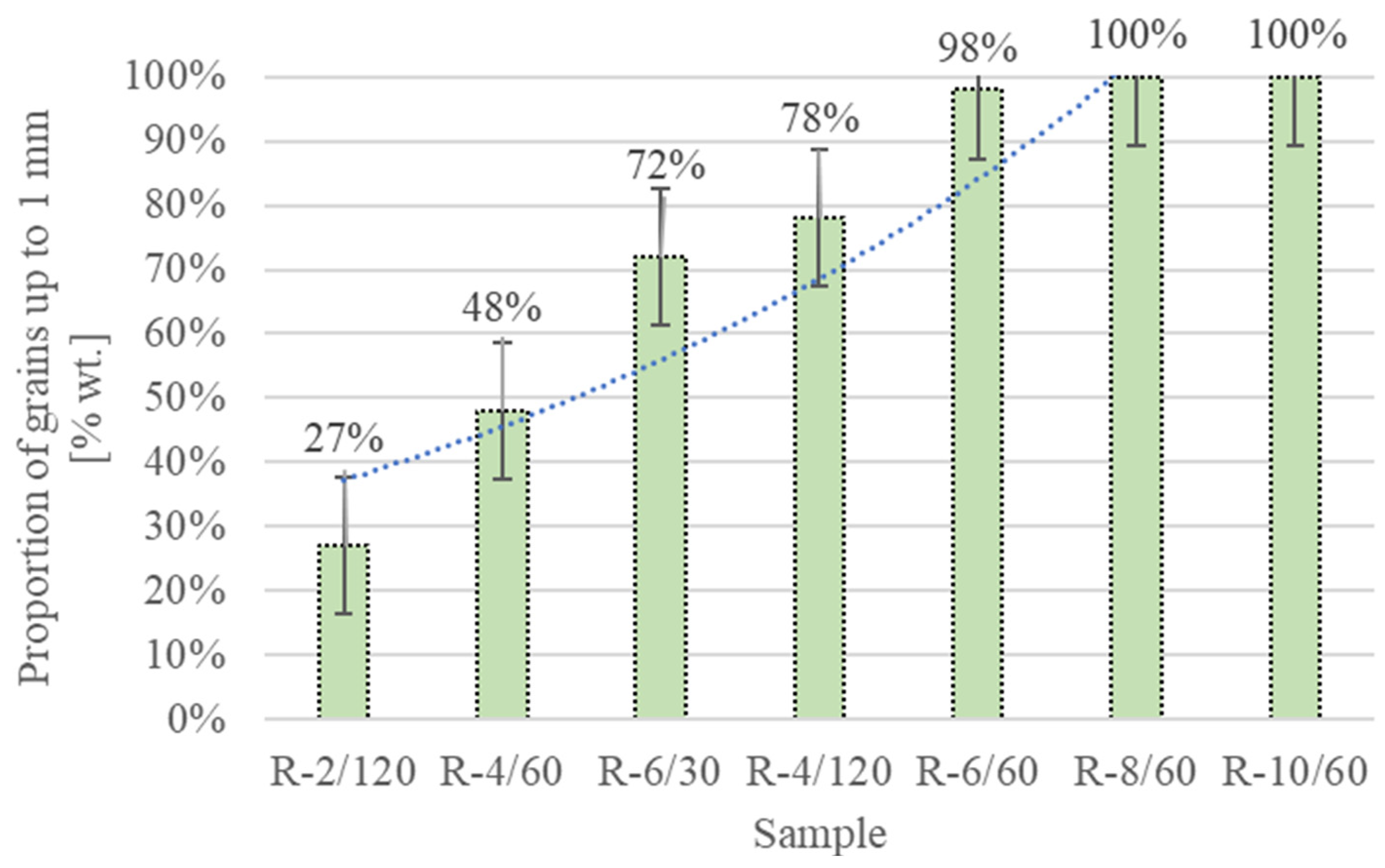
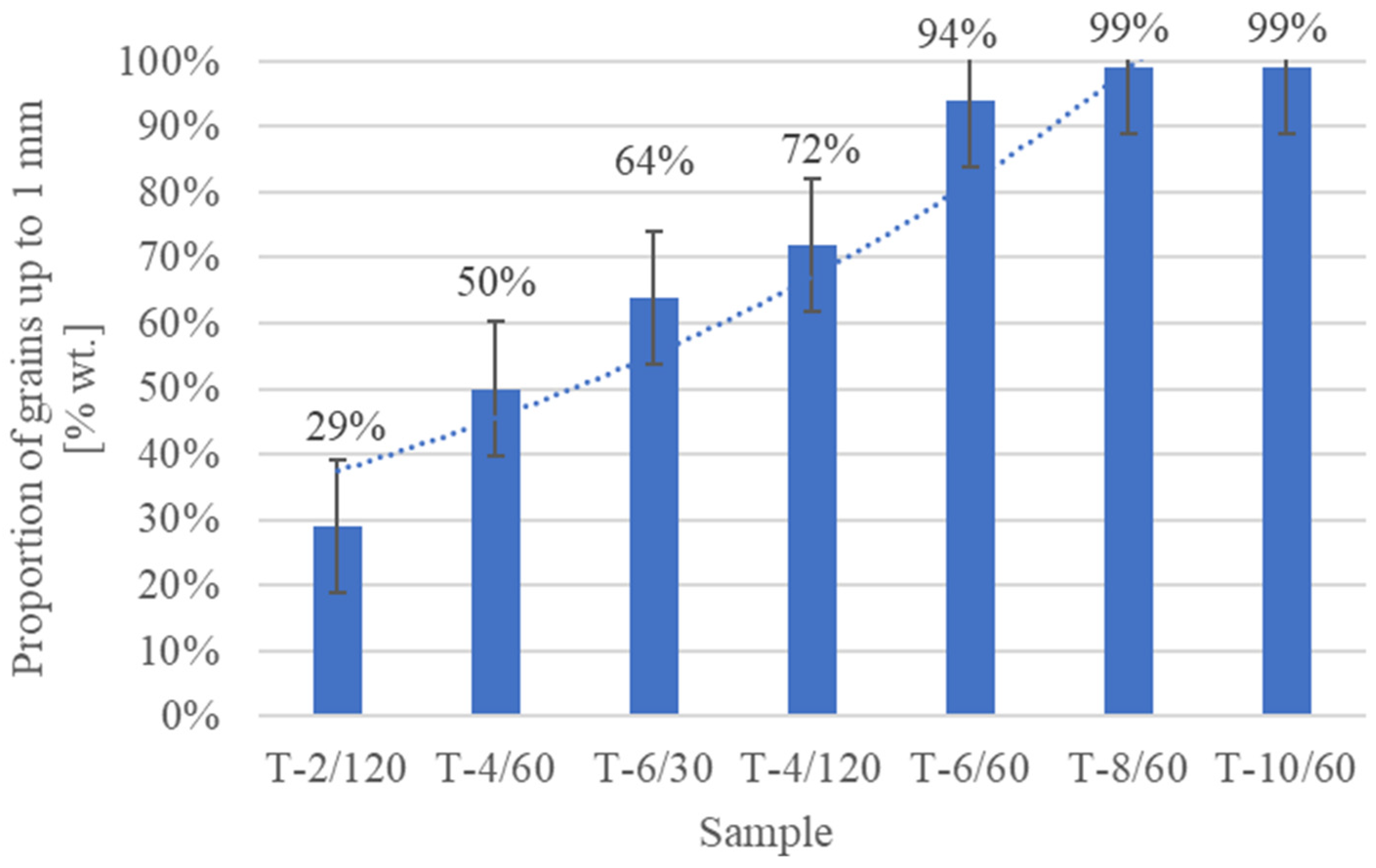
References
- Cosentino, L.; Fernandes, J.; Mateus, R. Fast-Growing Bio-Based Construction Materials as an Approach to Accelerate United Nations Sustainable Development Goals. Appl. Sci. 2024, 14, 4850. [Google Scholar] [CrossRef]
- Girijappa, Y.G.T.; Rangappa, S.M.; Parameswaranpillai, J.; Siengchin, S. Natural Fibers as Sustainable and Renewable Resource for Development of Eco-Friendly Composites: A Comprehensive Review. Front. Mater. 2019, 6, 226. [Google Scholar] [CrossRef]
- GREEN Deal EU Documents and Directives. Available online: https://www.consilium.europa.eu/cs/policies/green-deal/fit-for-55-the-eu-plan-for-a-green-transition/ (accessed on 5 January 2025).
- Energy Performance of Buildings Directive. Available online: https://energy.ec.europa.eu/topics/energy-efficiency/energy-efficient-buildings/energy-performance-buildings-directive_en (accessed on 5 January 2025).
- Balador, Z.; Gjerde, M.; Isaacs, N.; Imani, M. Thermal and Acoustic Building Insulations from Agricultural Wastes. In Handbook of Ecomaterials, 1st ed.; Martínez, L., Kharissova, O., Kharisov, B., Eds.; Springer: Cham, Switzerland, 2018; pp. 2237–2257. [Google Scholar] [CrossRef]
- Bousshine, S.; Ouakarrouch, M.; Bybi, A.; Laaroussi, N.; Garoum, M.; Tilioua, A. Acoustical and thermal characterization of sustainable materials derived from vegetable, agricultural, and animal fibers. Appl. Acoust. 2022, 187, 108520. [Google Scholar] [CrossRef]
- Borrega, M.; Hinkka, V.; Hörhammer, H.; Kataja, K.; Kenttä, E.; Ketoja, J.A.; Palmgren, R.; Salo, M.; Sundqvist-Andberg, H.; Tanaka, A. Utilizing and Valorizing Oat and Barley Straw as an Alternative Source of Lignocellulosic Fibers. Materials 2022, 15, 7826. [Google Scholar] [CrossRef]
- Loh, T.W.; Nguyen, K.T. Durability and fire resistance of compressed wheat-straw (Triticum aestivum) panels subjected to real-world aging environments. Ind. Crops Prod. 2023, 203, 117141. [Google Scholar] [CrossRef]
- Revuelta-Aramburu, M.; Verdú-Vázquez, A.; Gil-López, T.; Morales-Polo, C. Environmental analysis of the use of plant fiber blocks in building construction. Sci. Total Environ. 2020, 725, 138495. [Google Scholar] [CrossRef]
- Ashour, T.; Wu, W. Using barley straw as building material. In Barley: Production, Cultivation and Uses; Elfson, S.B., Ed.; Nova Science Publishers, Inc.: Hauppauge, NY, USA, 2011; pp. 1–28. [Google Scholar]
- Křen, J.; Neudert, L.; Procházková, B.; Smutný, V. General Plant Production—Part 1; Mendel University in Brno: Brno, Czech Republic, 2015. [Google Scholar]
- International Production Assessment Division—Foreign Agricultural Service, U.S. Department of Agriculture. Available online: https://ipad.fas.usda.gov/ (accessed on 4 April 2025).
- Román-Gutiérrez, A.D.; Duana-Ávila, D.; Hernández-Ávila, J.; Cerecedo-Saenz, E.; Salinas-Rodríguez, E.; Rojas-León, A.; López Perea, P. Reuse of Barley Straw for Handmade Paper Production. Sustainability 2022, 14, 12691. [Google Scholar] [CrossRef]
- Trading Economics. Available online: https://tradingeconomics.com/poland/oats-spring-cereal-mixtures-harvested-production-in-eu-stard-humidity-eurostat-data.html (accessed on 4 April 2025).
- Bakatovich, A.; Davydenko, N.; Gaspar, F. Thermal insulating plates produced on the basis of vegetable agricultural waste. Energy Build. 2018, 180, 72–82. [Google Scholar] [CrossRef]
- Canola Council of Canada. Available online: https://www.canolacouncil.org/markets-stats/production/?utm_source=chatgpt.com (accessed on 4 April 2025).
- Svärd, A.; Brännvall, E.; Edlund, U. Rapeseed straw polymeric hemicelluloses obtained by extraction methods based on severity factor. Ind. Crops Prod. 2017, 95, 305–315. [Google Scholar] [CrossRef]
- Hajj Obeid, M.; Douzane, O.; Freitas Dutra, L.; Promis, G.; Laidoudi, B.; Bordet, F.; Langlet, T. Physical and Mechanical Properties of Rapeseed Straw Concrete. Materials 2022, 15, 8611. [Google Scholar] [CrossRef]
- Research Institute of Plant Production, Public Research Institution. The origin of triticale, its importance and the hybridization of wheat with other genera. Cereal J. 2017, XXV, 44–48. [Google Scholar]
- AgNews, Triticale Market Size & Share Analysis—Growth Trends & Forecasts (2023–2028)-Report, Europe’s Triticale Dominance: Poland Leads as a Major Producer in Global Market. Available online: https://news.agropages.com/News/NewsDetail---47457.htm?utm_source=chatgpt.com (accessed on 4 April 2025).
- Vejeliene, J.; Gailius, A.; Vejelis, S.; Vaitkus, S.; Balciunas, G. Development of Thermal Insulation from Local Agricultural. Environ. Eng. 2011, 1, 437–440. [Google Scholar]
- Lesiecki, M.; Kawalerczyk, J.; Derkowski, A.; Wieruszewski, M.; Dziurka, D.; Mirski, R. Properties of Lightweight Insulating Boards Produced from Triticale Straw Particles. Materials 2023, 16, 5272. [Google Scholar] [CrossRef]
- Lebed, A.; Augaitis, N. Research of Physical Properties of Straw for Building Panels. Int. J. Eng. Sci. Invent. 2017, 6, 9–14. [Google Scholar]
- Björnsson, L.; Prade, T. Sustainable Cereal Straw Management: Use as Feedstock for Emerging Biobased Industries or Cropland Soil Incorporation. Waste Biomass Valorization 2021, 12, 5649–5663. [Google Scholar] [CrossRef]
- Chen, B.; Mohrmann, S.; Li, H.; Gaff, M.; Lorenzo, R.; Corbi, I.; Corbi, O.; Fang, K.; Li, M. Research and Application Progress of Straw. J. Renew. Mater. 2023, 11, 599–623. [Google Scholar] [CrossRef]
- Materna, T. The State Agricultural Intervention fund, Market Information System of the Czech Republic. Cereals, Oilseeds and Feed Market Report, 2 February 2024; pp. 1–16. [Google Scholar]
- Hroudová, J.; Zach, J. The possibilities of modification of crop-based insulation materials applicable in civil engineering in low-energy and passive houses. Procedia Eng.—Spec. Issue 2017, 180, 1186–1194. [Google Scholar] [CrossRef]
- Korjenic, A.; Petránek, V.; Zach, J.; Hroudová, J. Development and performance evaluation of natural thermal-insulation materials composed of renewable resources. Energy Build. 2011, 43, 2518–2523. [Google Scholar] [CrossRef]
- Krasny, E.; Klaric, S.; Korjenic, A. Analysis and comparison of environmental impacts and cost of biobased house versus concrete house. J. Clean. Prod. 2017, 161, 968–976. [Google Scholar] [CrossRef]
- Fialová, Z. The harvest of cereals and rapeseed is practically over in the Czech Republic. Farmer, 29 August 2023. [Google Scholar]
- Czech Statistical Office. Area and Structure of Agricultural Land According to Ownership in 2024; Czech Statistical Office: Záběhlice, Czech Republic, 2024. [Google Scholar]
- El Mansouri, N.-E.; Espinach, F.X.; Julian, F.; Verdaguer, N.; Torres, L.; Llop, M.F.; Mutje, P. Research on the suitability of organosolv semi-chemical triticale fibers as reinforcement for recycled hdpe composites. Bioresources 2012, 7, 5032–5047. [Google Scholar] [CrossRef][Green Version]
- Zommere, G.; Vilumsone, A.; Kalnina, D.; Solizenko, R.; Stramkale, V. Comparative Analysis of Fiber Structure and Cellulose Contents in Flax and Hemp Fibres. Mater. Sci. Text. Cloth. Technol. 2013, 8, 96–104. [Google Scholar] [CrossRef]
- Shen, W.J.Z.; Wen, Y. A Continuous Hydrothermal Saccharification Approach of Rape Straw Using Dilute Sulfuric Acid. BioEnergy Res. 2014, 7, 1392–1401. [Google Scholar] [CrossRef]
- Tarasov, D.; Leitch, M.; Fatehi, P. Lignin-carbohydrate complexes: Properties, applications, analyses, and methods of extraction: A review. Biotechnol. Biofuels 2018, 11, 269. [Google Scholar] [CrossRef] [PubMed]
- SAF: Sustainable Agribusiness Forum. Energy Characteristics of Sunflower By-Products. Available online: https://saf.org.ua/en/news/1172/ (accessed on 13 April 2021).
- Passoth, V.; Sandgren, M. Biofuel production from straw hydrolysates: Current achievements and perspectives. Appl. Microbiol. Biotechnol. 2019, 103, 5105–5116. [Google Scholar] [CrossRef]
- EN 15101-1; Thermal Insulation Products for Buildings—In-Situ Formed Loose Fill Cellulose (LFCI) Products—Part 1: Specification for the Products Before Installation. Czech Office for Standards, Metrology and Testing: Prague, Czech Republic, 2020.
- Ash in Wood, Pulp, Paper and Paperboard: Combustion at 525 °C. In Tappi Test Methods; Tappi T 211 om-02; Tappi Press Atlanta: Atlanta, GA, USA, 2007; ISBN 1-930657-33-1.
- Wise, L.E.; Murphy, M.; D’Addieco, A.A. Chlorite holocellulose, its fractionation and bearing on summative wood analysis and on studies on the hemicelluloses. Pap. Trade J. 1946, 122, 35–43. [Google Scholar]
- Acid-Insoluble Lignin in Wood and Pulp. In Tappi Test Methods; Tappi T 222 om-11; Tappi Press Atlanta: Atlanta, GA, USA, 2006; ISBN 1-930657-33-1.
- EN 1097-3; Tests for Mechanical and Physical Properties of Aggregates—Part 3: Determination of Loose Bulk Density and Voids. Czech Office for Standards, Metrology and Testing: Prague, Czech Republic, 1999.
- EN 933-1; Tests for Geometrical Properties of Aggregates—Part 1: Determination of Particle Size Distribution-Sieving Method. Czech Office for Standards, Metrology and Testing: Prague, Czech Republic, 2012.
- EN 12667; Thermal Performance of Building Materials and Products-Determination of Thermal Resistance by Means of Guarded Hot Plate and Heat Flow Meter Methods-Products of High and Medium Thermal Resistence. Czech Office for Standards, Metrology and Testing: Prague, Czech Republic, 2001.
- ISO 8301; Thermal Insulation—Determination of Steady-State Thermal Resistance and Related Properties—Heat Flow Meter Apparatus. The International Organization for Standardization: Geneva, Switzerland, 1991.
- Koh, C.H.; Gauvin, F.; Schollbach, K.; Brouwers, H.J.H. Upcycling wheat and barley straws into sustainable thermal insulation: Assessment and treatment for durability. Resour. Conserv. Recycl. 2023, 198, 107161. [Google Scholar] [CrossRef]
- Halásová, S. Development of Ecological Thermal Insulation Materials Based on Natural Raw Materials. Bachelor Thesis, Brno University of Technology, Faculty of Civil Engineering, Brno, Czech Republic, 2023. [Google Scholar]
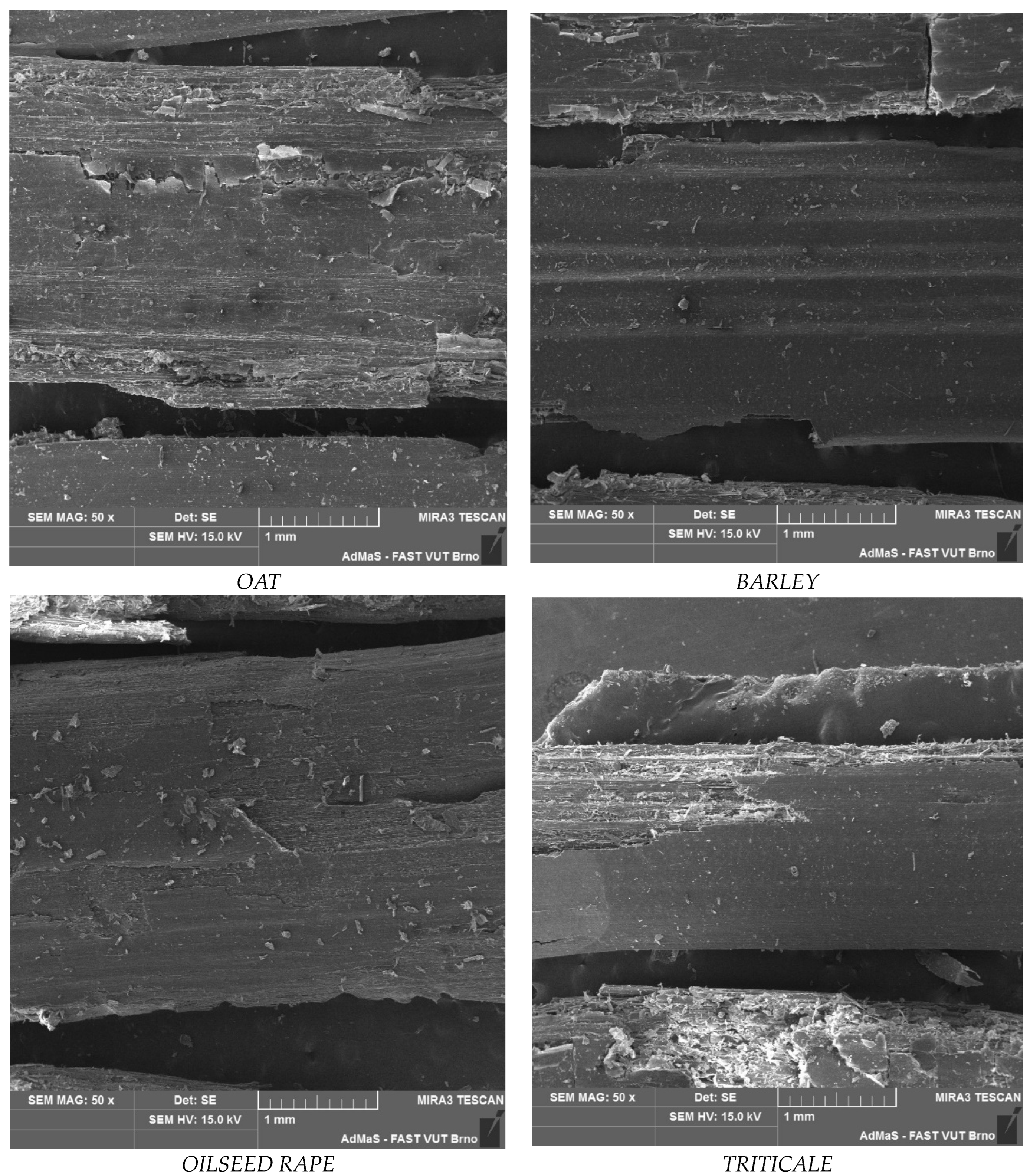

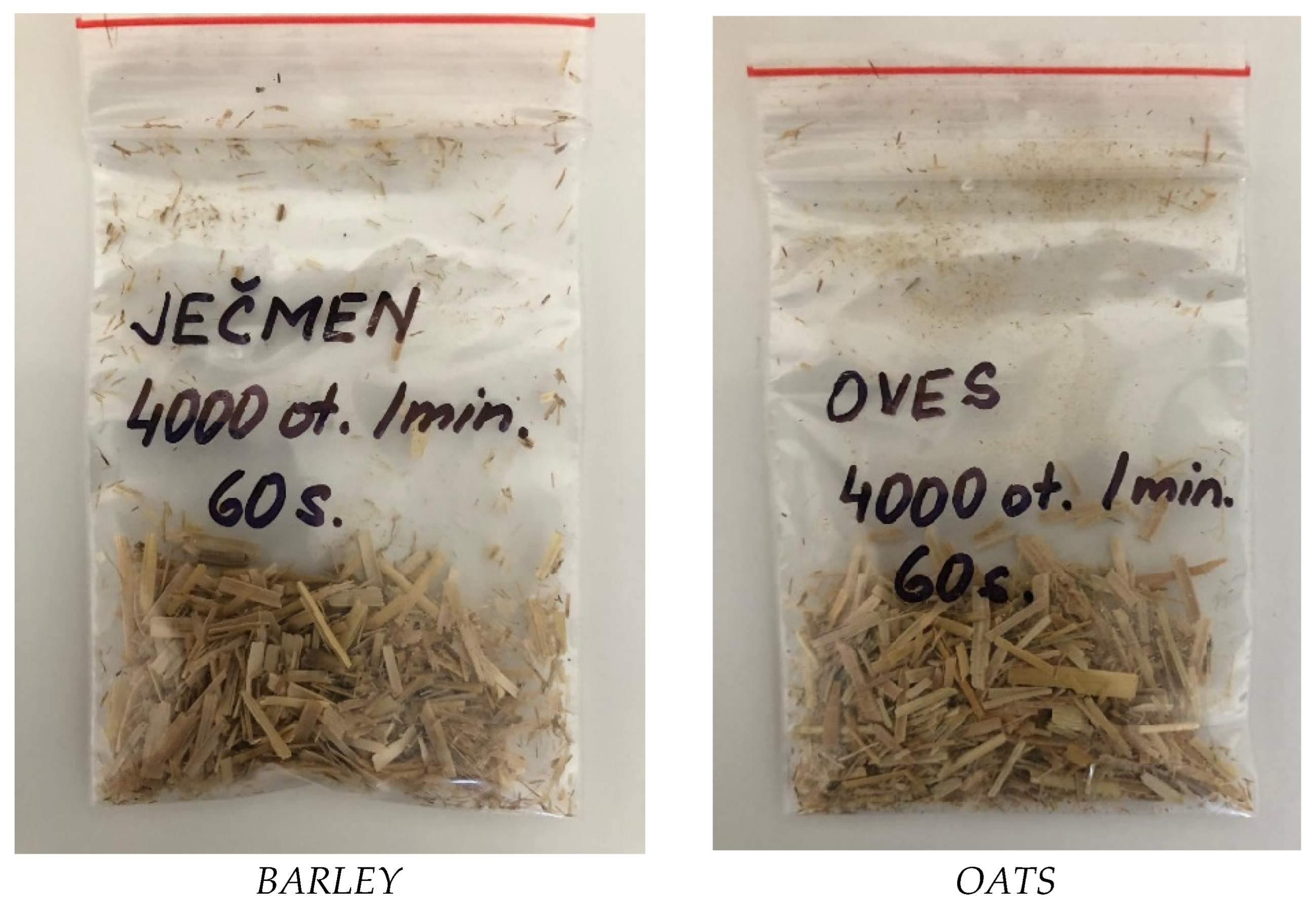
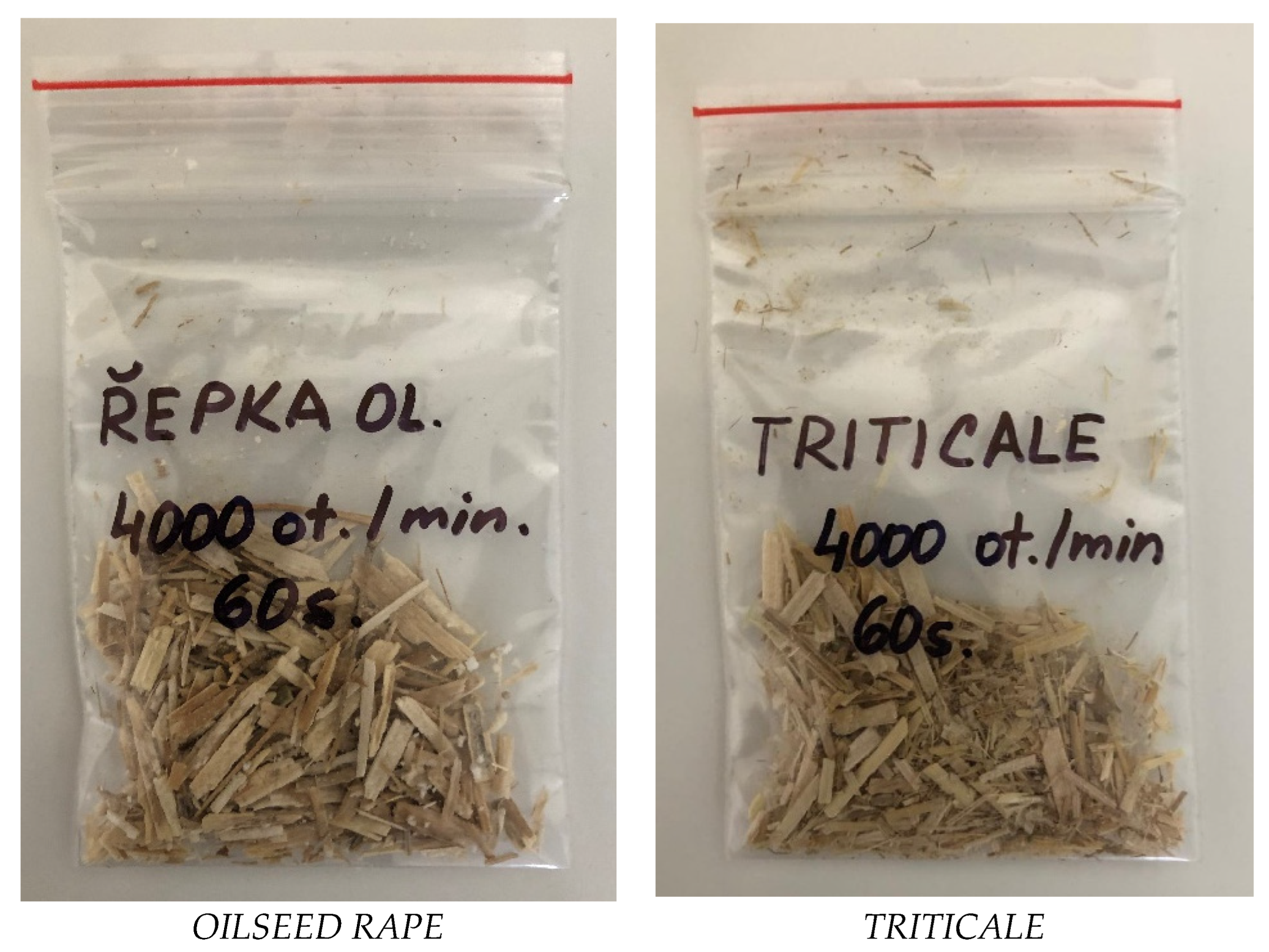
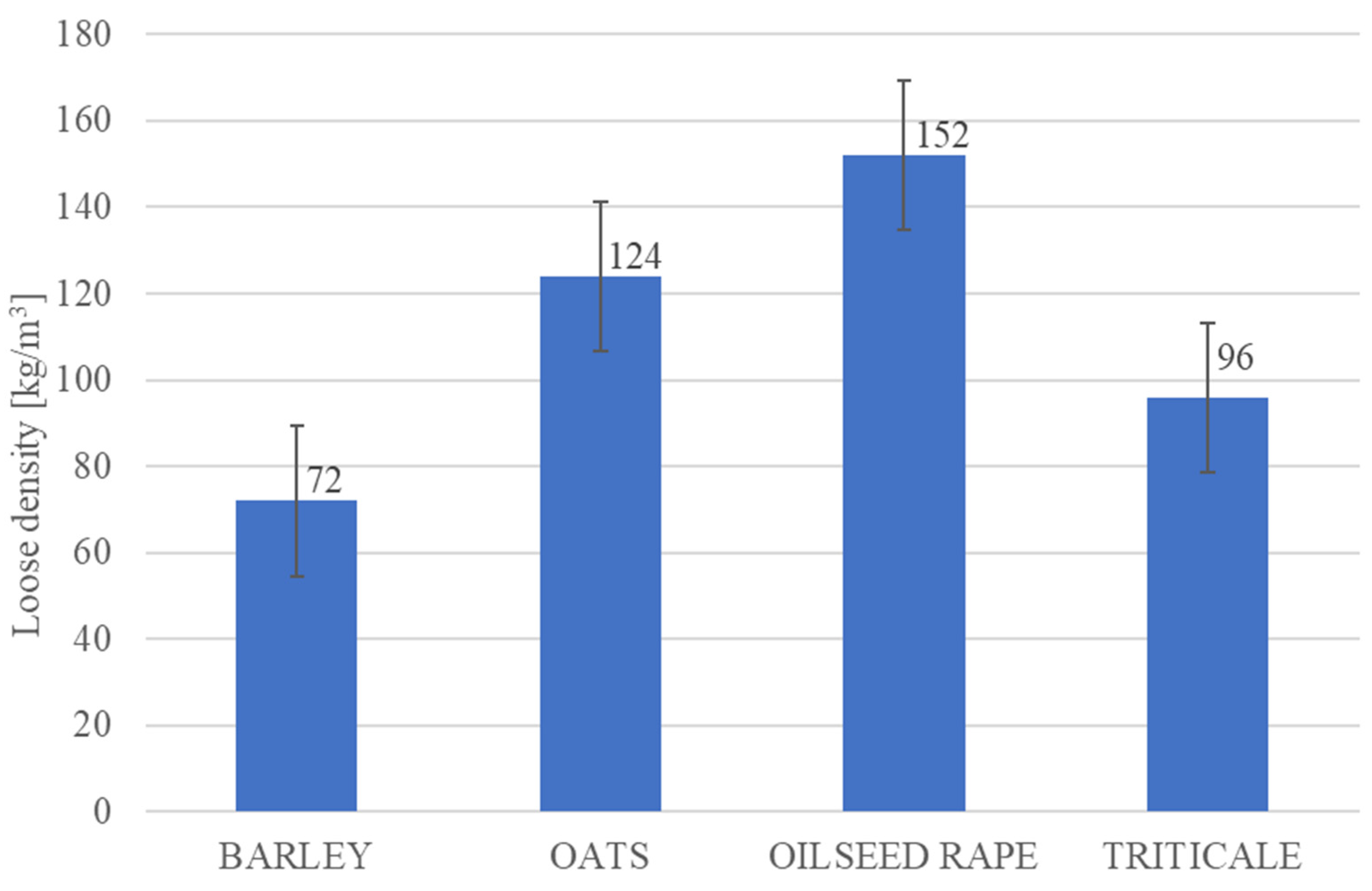



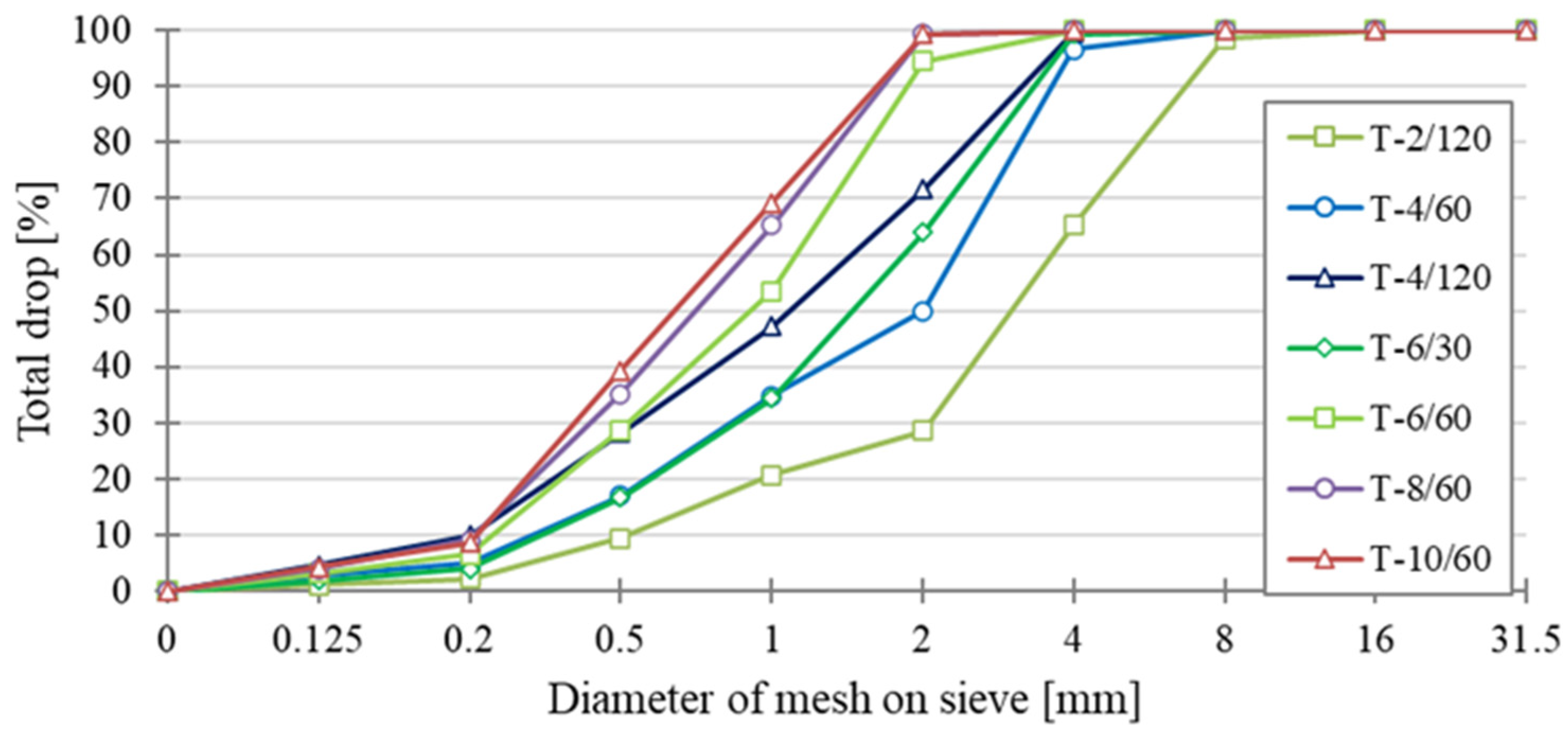
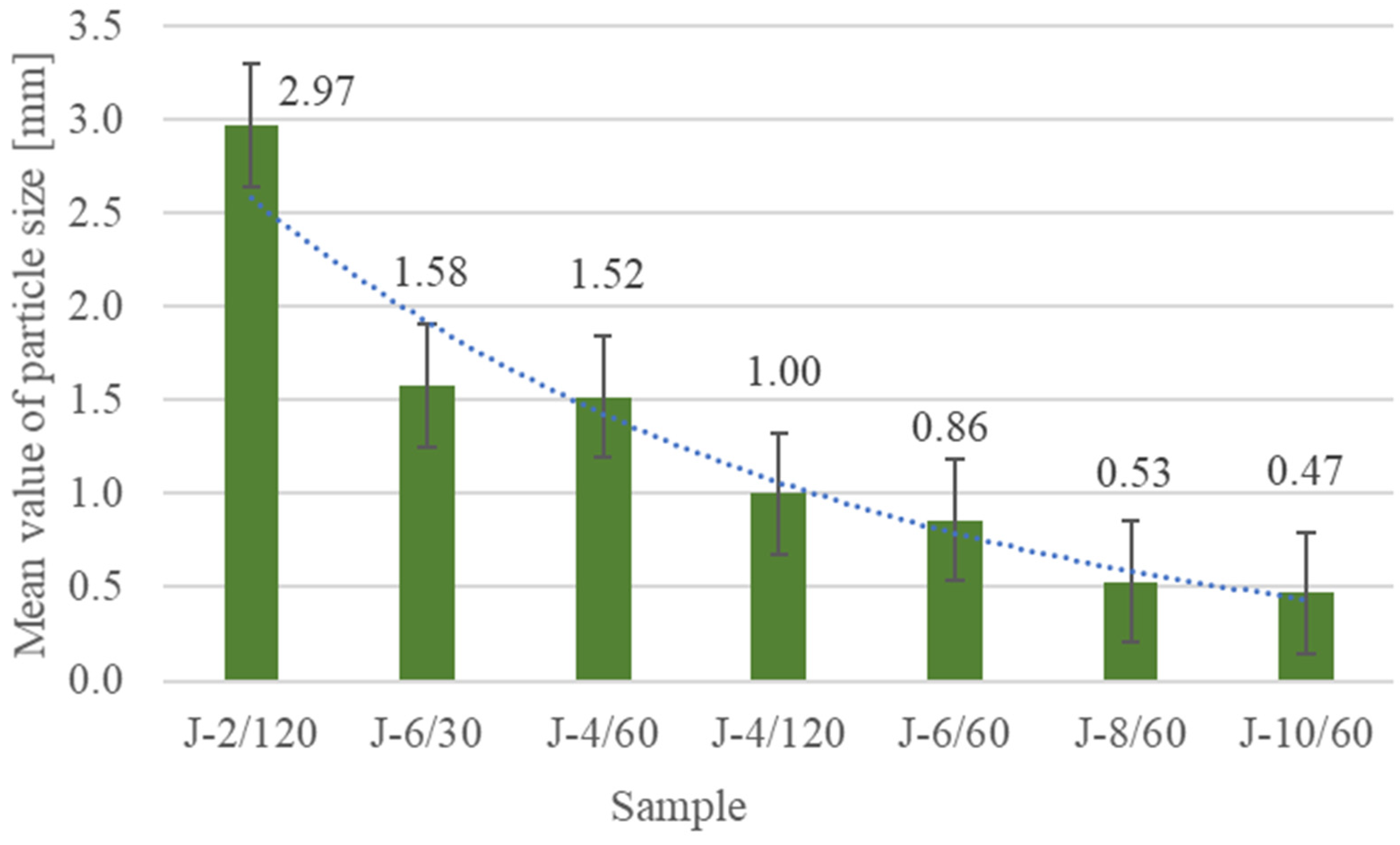
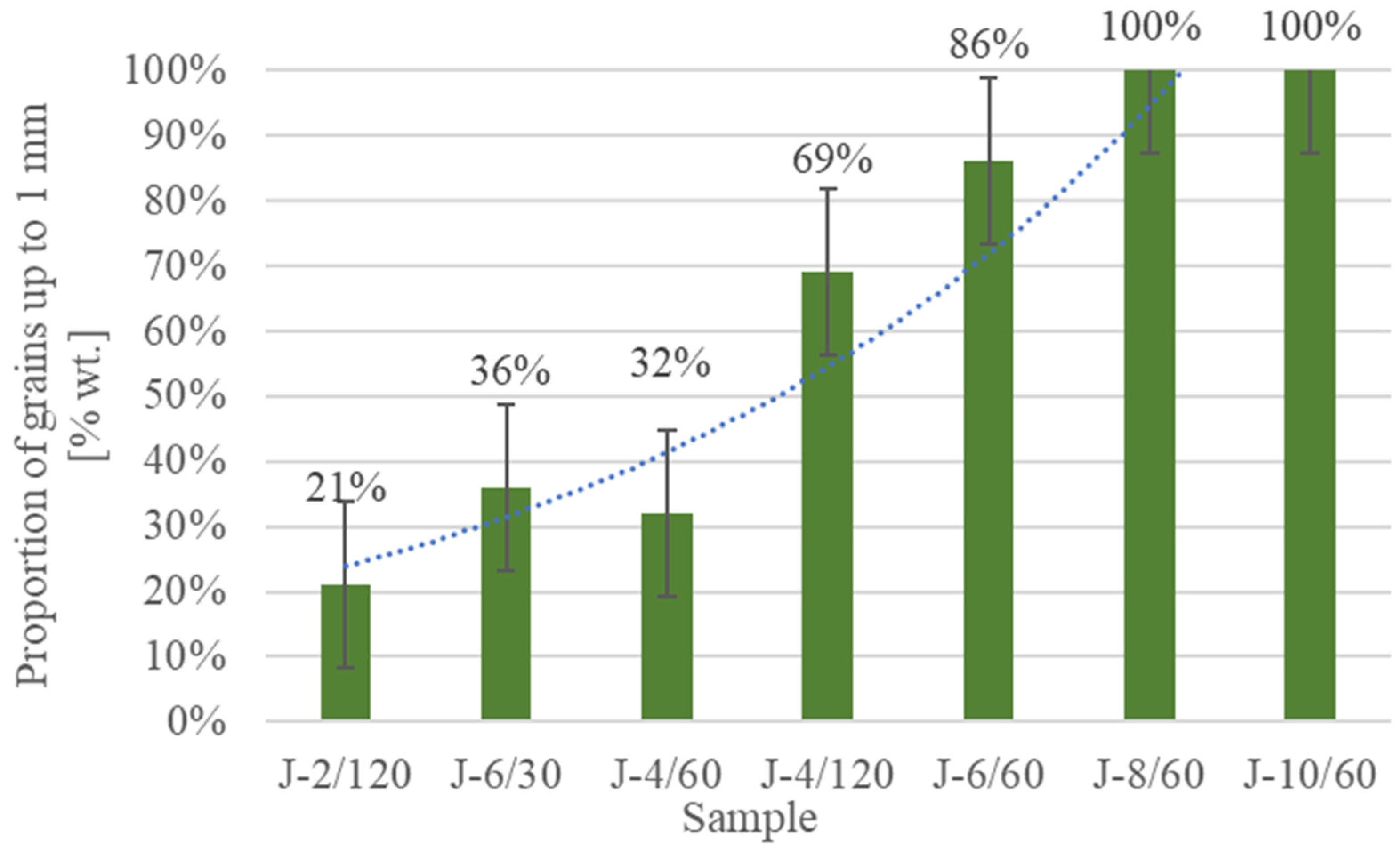
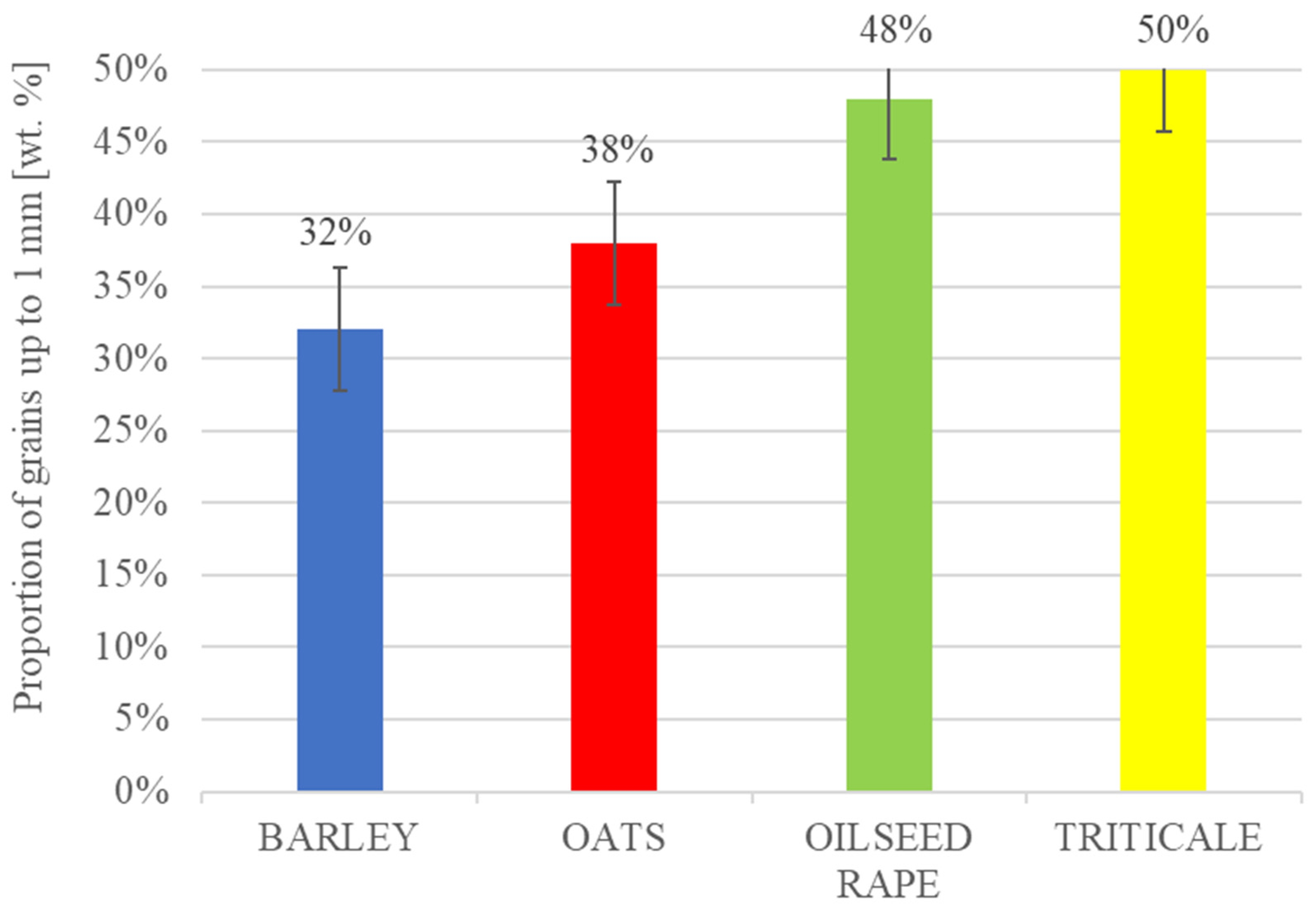

| Straw | Percentage Content (wt.%) | ||||
|---|---|---|---|---|---|
| Moisture | Fly Ash | Cellulose | Hemicellulose | Lignin | |
| Oats | 7.375 | 9.5 | 32 | 22 | 13 |
| Barley | 8.587 | 6.0 | 39 | 28 | 6 |
| Oilseed rape | 8.791 | 6.1 | 51 | 13 | 17 |
| Triticale | 7.485 | 6.8 | 50 | 26 | 15 |
| BARLEY | OATS | ||||
| Sample Designation | Grinding Frequency (rpm/min) | Grinding Time (s) | Sample Designation | Grinding Frequency (rpm/min) | Grinding Time (s) |
| J-2/120 | 2000 | 120 | O-2/120 | 2000 | 120 |
| J-4/60 | 4000 | 60 | O-4/60 | 4000 | 60 |
| J-4/120 | 4000 | 120 | O-4/120 | 4000 | 120 |
| J-6/30 | 6000 | 30 | O-6/30 | 6000 | 30 |
| J-6/60 | 6000 | 60 | O-6/60 | 6000 | 60 |
| J-8/60 | 8000 | 60 | O-8/60 | 8000 | 60 |
| J-10/60 | 10,000 | 60 | O-10/60 | 10,000 | 60 |
| TRITICALE | OILSEED RAPE | ||||
| Sample Designation | Grinding Frequency (rpm/min) | Grinding Time (s) | Sample Designation | Grinding Frequency (rpm/min) | Grinding Time (s) |
| T-2/120 | 2000 | 180 | R-2/120 | 2000 | 120 |
| T-4/60 | 4000 | 60 | R-4/60 | 4000 | 60 |
| T-4/120 | 4000 | 120 | R-4/120 | 4000 | 120 |
| T-6/30 | 6000 | 30 | R-6/30 | 6000 | 30 |
| T-6/60 | 6000 | 60 | R-6/60 | 6000 | 60 |
| T-8/60 | 8000 | 60 | R-8/60 | 8000 | 60 |
| T-10/60 | 10,000 | 60 | R-10/60 | 10,000 | 60 |
| Type of Straw | Sample | Loose Density (kg/m3) | Type of Straw | Sample | Loose Density (kg/m3) |
|---|---|---|---|---|---|
| BARLEY | J-2/120 | 50 | OILSEED RAPE | R-2/120 | 83 |
| J-4/60 | 72 | R-4/60 | 152 | ||
| J-4/120 | 91 | R-4/120 | 185 | ||
| J-6/30 | 75 | R-6/30 | 144 | ||
| J-6/60 | 89 | R-6/60 | 165 | ||
| J-8/60 | 108 | R-8/60 | 168 | ||
| J-10/60 | 117 | R-10/60 | 156 | ||
| OATS | O-2/120 | 79 | TRITICALE | T-2/120 | 79 |
| O-4/60 | 124 | T-4/60 | 96 | ||
| O-4/120 | 151 | T-4/120 | 132 | ||
| O-6/30 | 123 | T-6/30 | 98 | ||
| O-6/60 | 156 | T-6/60 | 107 | ||
| O-8/60 | 173 | T-8/60 | 112 | ||
| O-10/60 | 187 | T-10/60 | 110 |
| Raw Material Processing (Grinding Frequency in ths. rpm/min/time in s) | BARLEY | OAT | OILSEED RAPE | TRITICALE |
|---|---|---|---|---|
| 2/120 | 2.97 | 2.94 | 2.72 | 2.33 |
| 4/60 | 1.52 | 1.50 | 1.41 | 1.34 |
| 4/120 | 1.00 | 1.17 | 0.92 | 0.96 |
| 6/30 | 1.58 | 1.35 | 1.02 | 1.15 |
| 6/60 | 0.86 | 0.59 | 0.61 | 0.69 |
| 8/60 | 0.53 | 0.42 | 0.46 | 0.56 |
| 10/60 | 0.47 | 0.29 | 0.34 | 0.53 |
| Raw Material Processing (Grinding Frequency in ths. rpm/min/time in s) | BARLEY | OAT | OILSEED RAPE | TRITICALE |
|---|---|---|---|---|
| 2/120 | 21 | 23 | 27 | 29 |
| 4/60 | 32 | 38 | 48 | 50 |
| 4/120 | 69 | 57 | 78 | 72 |
| 6/30 | 36 | 46 | 72 | 64 |
| 6/60 | 86 | 98 | 98 | 94 |
| 8/60 | 100 | 100 | 100 | 99 |
| 10/60 | 100 | 100 | 100 | 99 |
| Type of Straw | OATS | BARLEY | OILSEED RAPE | TRITICALE | |||||
|---|---|---|---|---|---|---|---|---|---|
| Sample | O-4/60 | J-4/60 | R-4/60 | T-4/60 | |||||
| State | Loose | Compacted | Loose | Compacted | Loose | Compacted | Loose | Compacted | |
| Dimensions (mm) | a | 198.00 | |||||||
| b | 208.00 | ||||||||
| t | 23.20 | 23.58 | 22.71 | 23.15 | 23.98 | 24.61 | 22.86 | 23.50 | |
| Weight (g) | 122.68 | 151.32 | 55.31 | 65.68 | 136.73 | 165.16 | 115.29 | 130.23 | |
| Loose density (kg/m3) | 128 | 156 | 59 | 69 | 138 | 163 | 122 | 135 | |
| Thermal conductivity (W/(m·K)) | Measurement 1 | ||||||||
| 0.0420 | 0.0429 | 0.0367 | 0.0361 | 0.0451 | 0.0466 | 0.0424 | 0.0428 | ||
| Measurement 2 | |||||||||
| 0.0418 | 0.0429 | 0.0367 | 0.0359 | 0.0448 | 0.0465 | 0.0421 | 0.0427 | ||
| Measurement 3 | |||||||||
| 0.0415 | 0.0428 | 0.0363 | 0.0359 | 0.0446 | 0.0464 | 0.0421 | 0.0426 | ||
| Average value of thermal conductivity | |||||||||
| 0.0418 | 0.0428 | 0.0366 | 0.0360 | 0.0448 | 0.0465 | 0.0422 | 0.0427 | ||
Disclaimer/Publisher’s Note: The statements, opinions and data contained in all publications are solely those of the individual author(s) and contributor(s) and not of MDPI and/or the editor(s). MDPI and/or the editor(s) disclaim responsibility for any injury to people or property resulting from any ideas, methods, instructions or products referred to in the content. |
© 2025 by the authors. Licensee MDPI, Basel, Switzerland. This article is an open access article distributed under the terms and conditions of the Creative Commons Attribution (CC BY) license (https://creativecommons.org/licenses/by/4.0/).
Share and Cite
Peterková, J.; Korjenic, A.; Zach, J.; Bydžovský, J.; Halásová, S.; Sesto, E. Analysis of the Possible Use of Straw from Agriculture as an Environmental Insulation Material in Buildings. Sustainability 2025, 17, 3589. https://doi.org/10.3390/su17083589
Peterková J, Korjenic A, Zach J, Bydžovský J, Halásová S, Sesto E. Analysis of the Possible Use of Straw from Agriculture as an Environmental Insulation Material in Buildings. Sustainability. 2025; 17(8):3589. https://doi.org/10.3390/su17083589
Chicago/Turabian StylePeterková, Jitka, Azra Korjenic, Jiří Zach, Jiří Bydžovský, Simona Halásová, and Eldira Sesto. 2025. "Analysis of the Possible Use of Straw from Agriculture as an Environmental Insulation Material in Buildings" Sustainability 17, no. 8: 3589. https://doi.org/10.3390/su17083589
APA StylePeterková, J., Korjenic, A., Zach, J., Bydžovský, J., Halásová, S., & Sesto, E. (2025). Analysis of the Possible Use of Straw from Agriculture as an Environmental Insulation Material in Buildings. Sustainability, 17(8), 3589. https://doi.org/10.3390/su17083589









